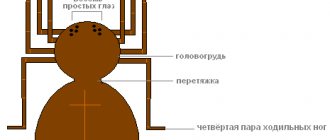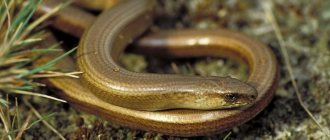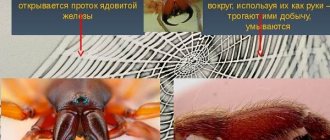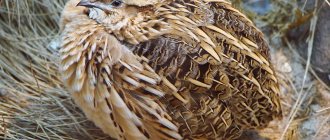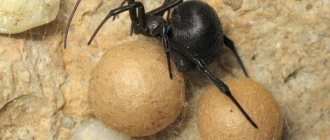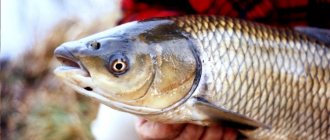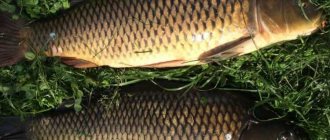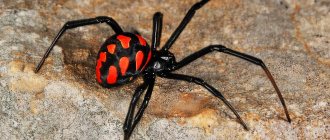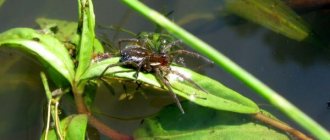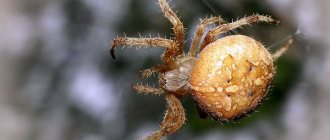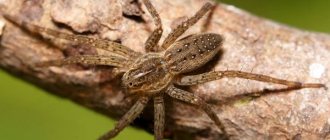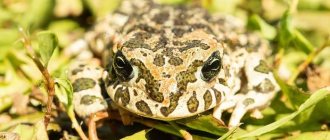The spider kingdom is diverse and numerous. In our homes, we usually see small six-fingered arachnids that weave their webs in corners and other shaded places. However, they can remain undetected for quite a long time. But in the world of spiders there are also real giants, the span of their paws surprises, and even inspires fear in some. We invite you to consider the TOP 10 largest representatives of the spider kingdom and find out what the largest spider in the world looks like and what size it is.
Nephilic Orbweaver
Body Size:
up to 4 cm.
Paw span:
up to 12 cm.
Photo: funart.pro
This is a tree spider that weaves the largest web in the world, and at the same time it is the largest spider that weaves it in general. In reality, it is nephiles, not tarantulas, that pose the real threat to birds. The neurotoxins in the venom are not lethal to humans, and the effects of the bite disappear within a couple of days.
Danger to humans
Like the vast majority of spiders, nephila does not pose a danger to humans. Their poison is primarily intended for insects caught in the web and almost immobilized.
Therefore, when bitten, blisters, sharp pain, and, in some cases, fever may appear. But all symptoms usually go away within 24 hours. The exception is people who are allergic to spider venom or any of its individual components. In this case, serious inflammation is possible. Asthmatics have difficulty breathing.
Since the chelicerae of spiders are quite powerful, a bite may well leave a scar on thin skin that will last for many years.
Huntsman Spider
Body Size:
up to 5 cm.
Paw span:
up to 17 cm.
Photo: mirros.ru
This is a whole family of large and predominantly Australian spiders, which we often see in pictures about the horrors of this continent. The paw span of individual individuals can reach up to 30 cm. Although huntsman spiders are scary, jumping, sudden and hunt openly, they are quite harmless to humans.
Top 10 tallest buildings in the world
Heteropoda Maxima
Body Size:
up to 5 cm.
Paw span:
up to 25 cm.
Photo: biopat.de
Although this giant crab spider, originally from Laos, does not have the most impressive body size, the span of its legs is truly record-breaking. The brown cave spider is rarely seen by humans and looks much more terrifying than it actually is.
How to weave a web
The web is a special kind of art. It is a kind of triangle, one side of which is in the air, and the other two are connected to each other near the ground. Inside this triangle, a web is woven, diverging from the center to the edges in the form of a spiral.
The web has a very neat appearance - the cells of one row do not differ from each other in size and increase in proportion to the web. Its radius can vary from several centimeters to a meter. The main threads have a special adhesive coating, once touched, the victim will no longer be able to free himself. And the spider will get to it painlessly along dry “paths”.
Did you know? Some orb weavers have even managed to travel to space. And in conditions of weightlessness, the pattern of their web remained unchanged.
By the way, weaving begins with dry threads, after completing which the spider begins to make catching nets. A fairly thick thread is pulled through the finished web, which serves as a kind of “bell” - it is thanks to its vibrations that the spider understands that it is time for him to have lunch. After eating its next prey, the spider checks its web and tightens stretched threads or connects broken threads. It takes the spider about 1–2 hours to complete this masterpiece. Males do not participate in weaving.
Cerbal Arabian
Body Size:
up to 6 cm.
Paw span:
up to 20 cm.
Photo: sprintally.com
This spider lives in Saudi Arabia, Israel and Jordan. It has a characteristic yellowish coloration, which allows it to camouflage itself in the sand. Cerbal leads a secretive and nocturnal lifestyle, so it was discovered quite recently - in 2003.
Top 10 largest cities in the world
Brazilian wandering spider
Body Size:
up to 7 cm.
Paw span:
up to 17 cm.
Photo: krasivosti.pro
These spiders come from South America, are very poisonous and dangerous to humans. They can run and jump briskly, thanks to which they successfully hunt birds and lizards. Wandering spiders love to hide in things, boxes, shoes or hats.
Who are they hunting?
Like the vast majority of spiders, nephila hunts insects. Moreover, due to its size, it needs a large amount of food. Therefore, he makes quite large networks. The largest web of nephil spiders can have an area of one square meter or even more! Of course, a lot of insects get here - even very voracious individuals have enough food.
However, other spiders also skillfully take advantage of the large size of the web. Having poor eyesight, nephila cannot visually monitor the entire area of its network. Therefore, it relies exclusively on touch. When the victim falls into the web, it twitches, and the spider, immediately noticing the vibrations of the threads, hurries to the prey to feast on it.
But another spider - Argyrodes colubrinus - does not like to build webs, especially such large ones. Instead, they prefer to parasitize larger relatives. Knowing well that the nephila will not be able to see small competitors, they carefully run through the network, without causing much hesitation, like a victim. Thin legs allow the parasites not to stick to the sticky web and to reach the insects caught in the net immediately after the nephila euthanizes them and carefully wraps them with strong thread. After this, the small spiders feast to the fullest, and the owner of the web gets only scraps.
Sometimes the network woven by one nephila spider can be occupied by more than ten small neighbors. As a result, the owner simply has nothing to eat. As a result, he has to leave the old web and move away from it and the parasites in order to weave a new network.
The size of the spider determines the thickness of the thread it produces and, accordingly, its strength. The strongest web of nephil spiders is quite capable of supporting the weight of a small bird. And the large area of the net leads to the fact that birds are caught in them quite often. True, spiders do not eat them, but out of habit they wrap them in a cocoon. This gave rise to a bunch of rumors that nephiles feed not only on insects, but also on birds.
Camel spider
Body Size:
up to 7 cm.
Paw span:
up to 22 cm.
Photo: domvred.ru
Salpugs are called sun spiders and wind scorpions in many different ways. But still, these are omnivorous arachnids native to desert regions. They have very powerful cutting jaws and jumping legs, and the structure of their eyes really resembles a scorpion. A salpuga bite is not particularly dangerous to humans, but can cause inflammation.
Phalanx
Because of the hump on their back, they are also called camel spiders. They are very active and representatives of almost all species are nocturnal hunters. Camel spiders have sparse hair on their body and limbs.
Quite remarkable is their vision. The phalanges have a scorpion-like arrangement of eyes: one pair is located in front and one more eye on the sides. Moreover, they are all complex, distinguish light and react to movement. And as a result - an excellent reaction with a minimum delay of a split second (like a fly). Thus, phalanxes are not only excellent hunters, but also almost elusive prey.
Another remarkable feature of the phalanges is their large, strong chelicerae, which are capable of biting not only the skin, but even a human nail. Each chelicera consists of two parts connected by a joint and looks very much like a crab claw. With their help, spiders cut feathers and hair from the body of their prey, which they subsequently cover the bottom of their nest with.
Characteristic:
- body size reaches 7 cm;
- leg span can be 23-24 cm;
- color yellow-brown;
- found everywhere except the Australian continent, lives mainly in desert areas;
- feeds on small arthropods, sometimes lizards are present in the diet.
Purple tarantula
Body Size:
up to 9 cm.
Paw span:
up to 23 cm.
Photo: ivbg.ru
Perhaps one of the most beautiful members of our top thanks to the unusual blue-violet hue of his body. These tarantulas are not dangerous to people, and they are often kept in terrariums. In nature they are found in Colombia, Malaysia, and Singapore.
20 most beautiful places in the world that you must visit
Giant baboon spider
Body Size:
up to 10 cm.
Paw span:
up to 25 cm.
Photo: zen.yandex.ru
The poisonous South American spider got its name because its limbs resemble those of a monkey. Although it is toxic, it almost never attacks first, but only defends itself. First of all, he instills fear in the enemy - he rises to his paws and hisses.
Where do they live?
As mentioned above, today scientists know about 30 varieties of nephiles. Spiders are found in different countries and even on different continents, in almost all parts of the world. They are found in Australia and Oceania, Asia and South America. But apparently, the homeland of the nephila spider is Africa. It is here that the largest number of varieties has been recorded.
Some species are found only in a relatively small area. For example, Nephila ambigua, discovered in 1911, lives exclusively in New Guinea - it has never been seen in other parts of the world. But Nephila vitiana, which was discovered back in 1847, can be found in many countries of Oceania, for example Tonga, Fiji, Indonesia. It is difficult to say how he crossed vast territories. Perhaps quite accidentally, along with trees, branches or leaves that fell into the water and were carried away by the current. But its range is truly impressive.
Theraphose Blond
Body Size:
up to 10 cm.
Paw span:
up to 25 cm.
Photo: krasivosti.pro
Theraphosa Blonda is a tarantula spider, and the leg span of its largest known specimen was 28 cm. This is about the size of a large dinner dish. Spiders live in some regions of Brazil, Venezuela and Suriname, and feed on small rodents, toads and snakes.
Did you like the post? Subscribe to our channel in Yandex.Zen, it really helps us in our development!
The main giant of the spider world
Goliath tarantula
It is this representative of the tarantula species that is recognized as the largest spider in the world. The Goliath tarantula, thanks to its two-centimeter fangs, looks quite frightening. The paw span of an adult reaches about 27-28 cm, and the body weight is about 170 g. It attacks only when it feels threatened. In addition, when it bites, it does not always inject its toxic secretion, but even if this happens, it does not pose any particular danger to humans.
The goliath tarantula lives in the tropics of South America. He builds his own housing - he digs out a half-meter-long hole and covers it with a kind of door from his own web. The lifespan of females is about 25 years; males are given a much shorter amount of time by nature - no more than 6 years.
The galiath tarantula does not use webs for hunting. He waits for his prey in a secluded place and, when it approaches, makes a swift jump. The tarantula bites into its prey with its long chelicerae and immediately immobilizes it with venom. And since the spider itself is very large, it is unable to get enough of insects alone. In addition to them, its diet includes frogs, mice, lizards and even small snakes.
South Russian tarantula
Considering the largest arachnids on the planet, I would also like to mention the largest spider living in Russia. This is the South Russian tarantula: the body length of females is about 3 cm, males - no more than 2.5 cm. Compared to the individuals described above, it, of course, looks quite small.
Preferred zones for the South Russian tarantula are zones with dry climates, so it is most often found in desert, semi-desert and steppe regions, and rarely in forest-steppe.
To hunt, the South Russian tarantula digs a shallow hole and lines its walls and bottom with its web. When prey appears in his field of vision, he immediately jumps out of his hiding place and catches it. As a rule, the signal for an attack is a shadow hanging over the hole.
This is interesting! This feature makes it quite easy to lure the South Russian tarantula out of hiding - just tie a small button to a thread and dangle it over the hole!
The venom of the South Russian tarantula does not pose any particular danger to humans. Only swelling occurs at the site of the bite. Sometimes the skin around the affected area becomes yellow and remains this color for a month. Its poison does not cause death in humans.
